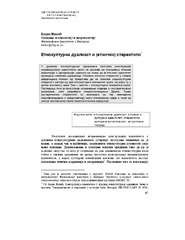Приказ основних података о документу
Etnokulturna dualnost i etnički stereotipi
Ethno-cultural duality and, ethnic, stereotypes
| dc.creator | Žikić, Bojan | |
| dc.date.accessioned | 2021-10-12T10:33:51Z | |
| dc.date.available | 2021-10-12T10:33:51Z | |
| dc.date.issued | 2005 | |
| dc.identifier.issn | 0350-0861 | |
| dc.identifier.uri | http://reff.f.bg.ac.rs/handle/123456789/499 | |
| dc.description.abstract | U dualnim etnokulturnim sredinama postupak konstrukcije individualnog identiteta često se zasniva na poklapanju etničke askripcije i deskripcije, odnosno na stavu da je etnički identitet primarna čovekova odrednica. Osnovni etnički stereotip u takvim zajednicama polazi od predstava da se lokalna sociokulturna stvarnost sastoji od dve etnokulturno kompaktne grupe, od kojih su u datom kontekstu samo Oni - zaista - etnokulturno kompaktna grupa. Posledica toga je prisutnije iskazivanje stavova o unutaretničkim razlikama, nego razrađeno stereotipiziranje Drugih. Takvi unutaretnički stereotipi su zasnovani na tzv. zavičajnim klasifikacijama i predstavljaju malu etnografiju ideja o tome od čega je sastavljena svaka lokalna etnička zajednica. | sr |
| dc.description.abstract | A construction of an individual identity, in dual ethno-cultural environments, is often based on a premise that an ethnic identity is a primary human determinant. In such dual ethno-cultural communities, a basic ethnic stereotype could be called „relational“: it is founded on the concept of „Others/We-group“ distinction, where the Others appear as a main reason for the existence of the We-group members who use the distinction. This stereotype is based on the following premises: the first one says that a local socio-cultural reality contains two solid ethno-cultural groups, whereas the other suggests that in a local context, there exist just „They“ as a solid ethno-cultural group while among „Us“ the solidity is in fact, limited to ethnic affiliation. The consequence of the attitude is pervasive presentation of intra-ethnic differences, more than mere stereotyping of the Others. These stereotypes are based on the so-called „homeland“ classifications and appear to represent a small ethnography of ideas and images on what constitutes and makes a local ethnic community. The stereotypes of this particular kind are more often seen among members of Serbian ethnic group, at least based on a research in two local communities - Bečej and Seleuš. In the two communities, the prevailing attitudes on intra-ethnic differences and the stereotypes developed out of the differences are more numerous and elaborated, based on the „homeland“ classification. This cultural, cognitive process is a consequence of intertwining of two perspectives in understanding of the We-group. The first perspective narrates about the We-group ethnic background, and the second emphasizes the group domicile, that is, it defines the We-group in space. The first perspective is founded, more or less, on indispensable experience of an ethnic identity, while the other perspective is more based on empirical experience; the second perspective is also a creation of a symbolic construction, the same as an image on an ethnic identity per se. | en |
| dc.publisher | Srpska akademija nauka i umetnosti SANU - Etnografski institut, Beograd | |
| dc.rights | openAccess | |
| dc.rights.uri | https://creativecommons.org/licenses/by-nc-nd/4.0/ | |
| dc.source | Glasnik Etnografskog instituta SANU | |
| dc.subject | stereotipi | sr |
| dc.subject | kulturna kognitivnost | sr |
| dc.subject | intuitivne teorije | sr |
| dc.subject | etnokulturna dualnost | sr |
| dc.subject | etnički i kulturni identitet | sr |
| dc.subject | stereotypes | en |
| dc.subject | intuitive theories | en |
| dc.subject | ethno-cultural duality | en |
| dc.subject | ethnic and cultural identity | en |
| dc.subject | cultural cognition | en |
| dc.title | Etnokulturna dualnost i etnički stereotipi | sr |
| dc.title | Ethno-cultural duality and, ethnic, stereotypes | en |
| dc.type | article | |
| dc.rights.license | BY-NC-ND | |
| dc.citation.epage | 81 | |
| dc.citation.issue | 53 | |
| dc.citation.other | (53): 67-81 | |
| dc.citation.spage | 67 | |
| dc.identifier.fulltext | http://reff.f.bg.ac.rs/bitstream/id/2038/496.pdf | |
| dc.identifier.rcub | https://hdl.handle.net/21.15107/rcub_reff_499 | |
| dc.type.version | publishedVersion |

